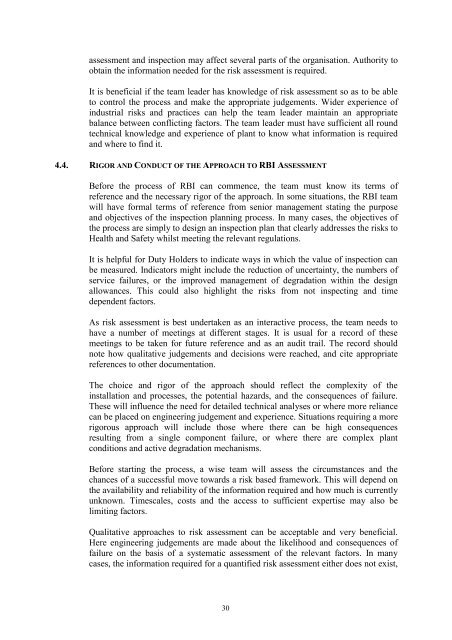Best Practice for Risk Based Inspection
risk based inspection
risk based inspection
You also want an ePaper? Increase the reach of your titles
YUMPU automatically turns print PDFs into web optimized ePapers that Google loves.
assessment and inspection may affect several parts of the organisation. Authority to<br />
obtain the in<strong>for</strong>mation needed <strong>for</strong> the risk assessment is required.<br />
It is beneficial if the team leader has knowledge of risk assessment so as to be able<br />
to control the process and make the appropriate judgements. Wider experience of<br />
industrial risks and practices can help the team leader maintain an appropriate<br />
balance between conflicting factors. The team leader must have sufficient all round<br />
technical knowledge and experience of plant to know what in<strong>for</strong>mation is required<br />
and where to find it.<br />
4.4. RIGOR AND CONDUCT OF THE APPROACH TO RBI ASSESSMENT<br />
Be<strong>for</strong>e the process of RBI can commence, the team must know its terms of<br />
reference and the necessary rigor of the approach. In some situations, the RBI team<br />
will have <strong>for</strong>mal terms of reference from senior management stating the purpose<br />
and objectives of the inspection planning process. In many cases, the objectives of<br />
the process are simply to design an inspection plan that clearly addresses the risks to<br />
Health and Safety whilst meeting the relevant regulations.<br />
It is helpful <strong>for</strong> Duty Holders to indicate ways in which the value of inspection can<br />
be measured. Indicators might include the reduction of uncertainty, the numbers of<br />
service failures, or the improved management of degradation within the design<br />
allowances. This could also highlight the risks from not inspecting and time<br />
dependent factors.<br />
As risk assessment is best undertaken as an interactive process, the team needs to<br />
have a number of meetings at different stages. It is usual <strong>for</strong> a record of these<br />
meetings to be taken <strong>for</strong> future reference and as an audit trail. The record should<br />
note how qualitative judgements and decisions were reached, and cite appropriate<br />
references to other documentation.<br />
The choice and rigor of the approach should reflect the complexity of the<br />
installation and processes, the potential hazards, and the consequences of failure.<br />
These will influence the need <strong>for</strong> detailed technical analyses or where more reliance<br />
can be placed on engineering judgement and experience. Situations requiring a more<br />
rigorous approach will include those where there can be high consequences<br />
resulting from a single component failure, or where there are complex plant<br />
conditions and active degradation mechanisms.<br />
Be<strong>for</strong>e starting the process, a wise team will assess the circumstances and the<br />
chances of a successful move towards a risk based framework. This will depend on<br />
the availability and reliability of the in<strong>for</strong>mation required and how much is currently<br />
unknown. Timescales, costs and the access to sufficient expertise may also be<br />
limiting factors.<br />
Qualitative approaches to risk assessment can be acceptable and very beneficial.<br />
Here engineering judgements are made about the likelihood and consequences of<br />
failure on the basis of a systematic assessment of the relevant factors. In many<br />
cases, the in<strong>for</strong>mation required <strong>for</strong> a quantified risk assessment either does not exist,<br />
30



